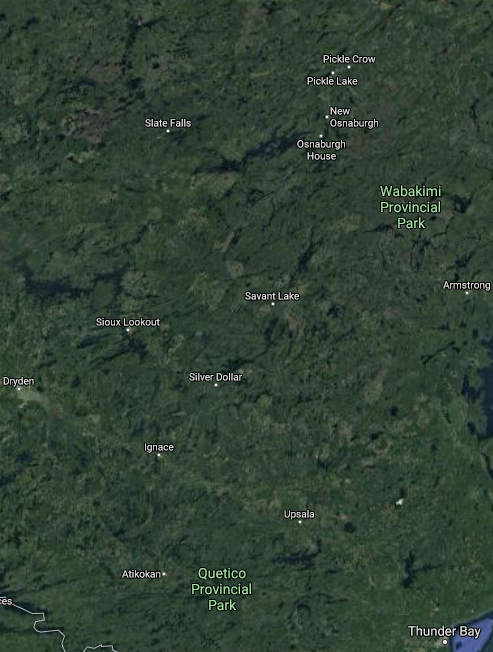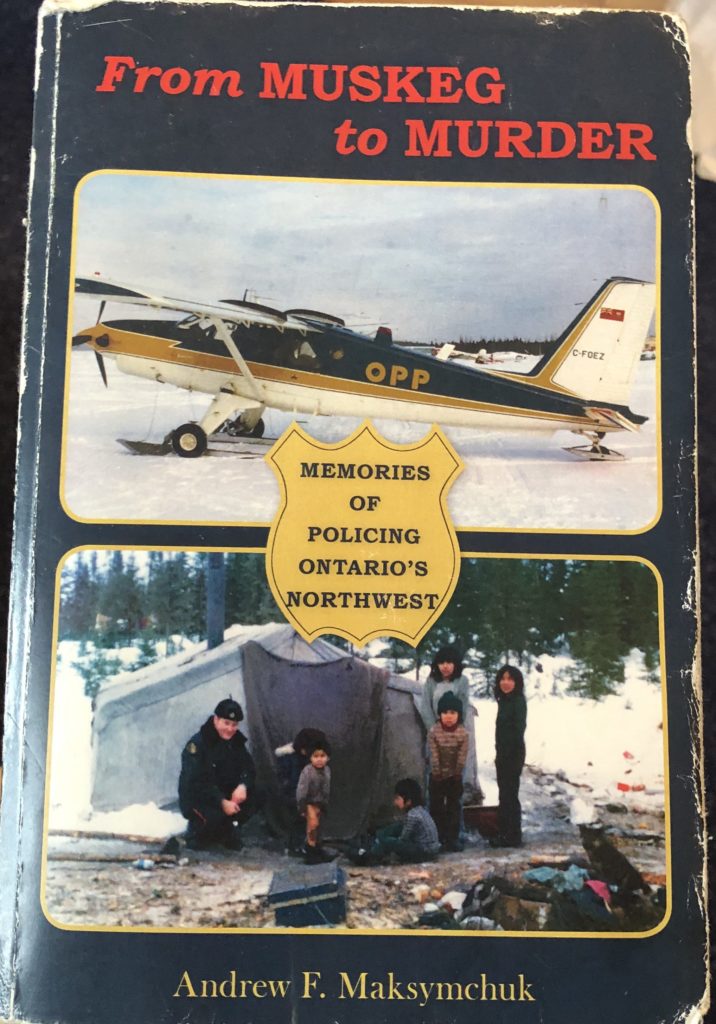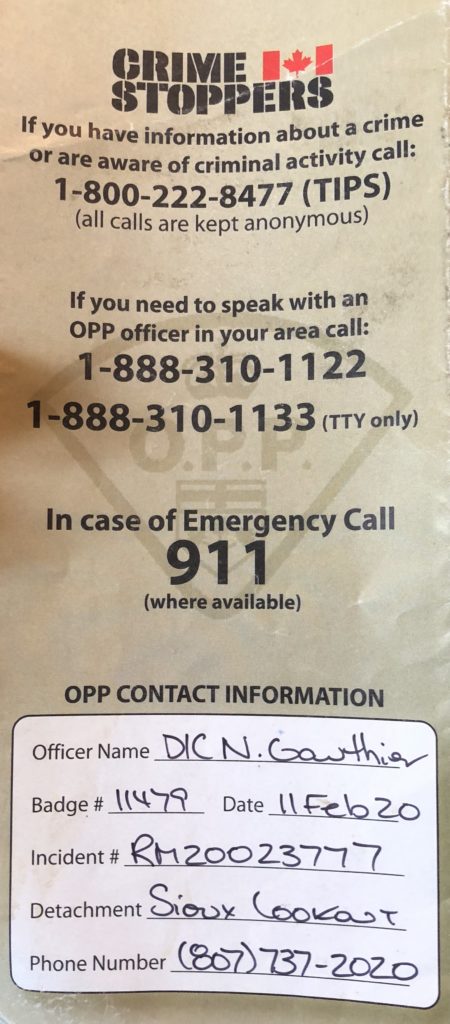Justice for Evelyn Wassaykeesic
A story of murder and corruption in Northern Ontario that might “break everything wide open.”
The article below is based on an interview conducted on March 11, 2020 with Gary Wassaykeesic about his efforts to secure justice for missing and murdered members of his community.
By Gary Wassaykeesic, special to Real People’s Media.
It’s been frustrating. People wonder why I’m angry or ask “why is he swearing so much?” or “why is he so aggressive?” It’s because I’m trying to tell you something! Ask me about Evelyn, and I’ll tell you all about Evelyn.
You have to understand that when you’re telling a story and you’re the victim, or your loved one or your family member has been killed, you’re going to show some anger. When I’m trying to tell my story about my cousin Evelyn and how she got killed, I’m gonna throw some swear words around. This ain’t a pretty story. This ain’t some walk in the park holding hands story. No. This is about murder. And murder is the bottom line, in any situation.
And as I’ve been trying to tell this story, by going to a MMIW office or some other social service office, I start by getting a little bit too aggressive. I’m an aggressive man. I do front line action and I say what needs to be said. You know, I’ll go up against cops, the government, or whoever I have to in order to get the word out.
When you’re entering an office down in Southern Ontario, you have to be kind and you have to have the proper manners and you have to present yourself in a suit and a tie. But I’m talking about murder here, and I use swear words because the people that have been killed are my relatives.
So it’s frustrating when I’m presenting my case to some 25 year old working their desk who doesn’t grasp that I’m trying to tell them that a MURDER has happened. They’re focused more on the aggressive manner that I’m giving. The swear words that I’m using. And right away they start cutting me off and telling me that they’re going to call security. They don’t take the time to listen to what I’ve been trying to tell them for years.
A ‘highway of murder’ leads to a “Ring of Fire”
The case with Evelyn is a case from when they built the highway through our community. It’s up in Northern Ontario where the ‘Ring of Fire’ is situated. To get access to the Ring of Fire you have to go through our community on that highway. And what a lot of people don’t realize is that there’s been a lot of happenings on the highway. And like I said, murder is the bottom line.

What a lot of people don’t know is that a lot of people found dead on that highway were dead before the trucks ran over them. David was dead before that van drove over him. And then you’ve got people like Ricky, who got hit over the head before he was put on the highway and dragged down it.
This is a story about the corruption in the community I come from. Back then it was heavy in corruption, and corruption kills. I have the documents to prove that. And by that I mean, in going through the Freedom of Information Act, in working with my brother and others, we went and got a list of how many people died on that highway.
I have a person that’s going to give me every detail, and he’s going to name names and the money that was flowing and how they were doing it. And like I said, it involves this story that I’ve been trying to tell and the documents that I got through the Freedom of Information Act – the Ontario Coroner’s death list.
If anybody knows how to look at that list and knows what they’re looking at, they’ll be shocked. For a small community like Mishkeegogoman to have all those casualties, murders, and house fires and shootings, stabbings. The professionals that I take this list to – psychiatrists, psychologists or even media people recognize it.
They say “what happened with this community? How come there’s so many casualties? There’s so much, for a small community.” Numbers like this are seen in major cities like Toronto or Vancouver – but for a small community like Mish?
Well, it all happened because corporations kill, and governments let it happen. There’s no accountability. No accountability from the Canadian government or Chief and Council. And guess who’s pulling the trigger? It’s the corporations, it’s the mining industry that’s situated up in the north. The Ring of Fire and the Mussel White gold mine, and other mines, and you’ve always got explorers and people coming into the area. They’ve already mined the rest of Canada. Now they’re focusing on Northern Ontario, where we’re considered the last frontier.
Currently I’m working on the case of my cousin Evelyn Wassaykeesic, and she was killed by this guy who I remember from when we were kids in a group home in Thunder Bay. I blame him for killing Evelyn, but he cannot take the total blame for that.
I blame the Chief and Council for their corruption at the time, and I blame the Canadian government for letting it happen. I also blame the corporations, the mining industry for being in agreement with these institutions. I have a real inside story. I have a real detailed account of what happened with Eveyln because I touched her that morning.
And there’s more than just Evelyn’s case – there’s about 6-7-8-9 cases that you could actually look at on that list that I have. I want to focus on Evelyn a little bit, because I have this feeling that Evelyn is going to break everything wide open.
Coroner’s List – Mishkeegogomang by Real Peoples Media on Scribd
Archbishop Desmond Tutu comes to Mishkeegogomang
Story after story has been written about our reserve. Desmond Tutu even came out to our reserve once. He was the ArchBishop of the Anglican church in South Africa, and he was called to come and to find out what was wrong with our community. All the shootings, all the killings, everybody landing in jail.
I was part of the process at the time. I was drinking, I went to jail. When I go through that Coroner’s list I remember every one of them, I’ve partied with them, did jail time with quite a few of them, and you know, that’s what the whole thing was about.

Desmond Tutu knows what poverty is. Desmond Tutu also knows what corruption is. But what Desmond Tutu didn’t know is that the Chief and Council that was doing the corruption at the time was in talks with Ontario Hydro and the Government of Canada because they put powerlines down the middle of our community, and we were in settlement talks with them for up to $200 million dollars at that time.
So when Desmond Tutu came into our community he was supposed to tour the community and look at the poverty and the “broken window syndrome” as they call it. Broken windows, shooting, killings, poverty, no food, whatever. Desmond Tutu was supposed to come in, tour the reserve, and then go back to his country where he comes from, and write a condemning letter to the Canadian government saying “what are you doing with these First Nations people?” And then the Canadian government was supposed to have settled on that $200 million deal with Hydro, and the Chief and Council would have been in control of the money.
Desmond Tutu knows a lot of things. But he didn’t say a damn thing about the corruption that was going on in our reserve. If he had said something, maybe one of my relatives would be alive today. I’ve been searching for organizations who were there at the time to see who actually mentioned anything or pointed any fingers, and I found that the charity Feed the Children came on our reserve from Britain. An international organization heard of our plight, heard of our misery and came on our reserve.
Feed the Children came the closest to actually pointing the finger. They wrote an article about where they’d been and what they’d seen, and there’s this one line where they almost point out the corruption that was going on, but then they never came back and never went any further with it. Our people – my relatives – are dying at the time, funeral after funeral.
I also have a big beef with the Toronto Star. They came on our reserve and wrote article after article in a series on our reserve and called us the “lost people”. How can you call us the “lost people” on our own land? On our own territory? The Toronto Star had enough time in the series to know about the corruption that was going on, but they wanted to cover the people going to jail and the people dying because misery sells papers.

Hitchhiking for Justice
In doing this work, you can drive yourself crazy. You know you’re bouncing off walls and trying to get the word out and nobody’s listening. And people are pointing at you like you have an anger problem and they’re wondering, “why is that guy so loud, why is he so aggressive?” But this is what I’ve been trying to tell people for a long time. And it just seems to go in one ear and out the other in southern Ontario and I still don’t get it.
One of the recent times I went up north, I was hitchhiking and got picked up by Crown Prosecutor Peter Keen who’s situated in Dryden. He told me, “I pick up hitchhikers.” I just happen to do a lot of hitchhiking just to go from point A to point B. If I have to go to Thunder Bay I don’t have the finances to hop on a plane or a train like most of these MMIW organizations will, but I’ll still do it.
I went to Thunder Bay this time around, as there were some different matters that I wanted to look into. Someone dropped me off about 30 miles out of Thunder Bay and I’m standing there for two or three hours in -30 below weather and I’m trying to make it to Sioux Lookout. I see a black truck coming and it stops so I get in, happy to get out of the cold. I make my introductions. I say, “I’m Gary” and he says, “I’m Peter.” When you get in you’re always friendly, shaking hands, and then you ask the question “so what do you do?”
People have all sorts of different reasons for picking up hitchhikers. Some of them are former hitchhikers, some of them want company for their drive. But this guy Peter says he’s a Crown Prosecutor. I say “really?” and he says, “does that make a difference? Do you want to get out now?” And I said, “no,” because I have all this information and paperwork with me and I just interviewed this witness for my dad’s murder case and I had all this information about Evelyn’s case.
He’s telling me he’s a crown prosecutor and we’re going to be driving for a couple hours, so I just seized the moment – I took it and ran with it. I just started feeding him all the information I had – everything that I’d been working on all of these years starting with my mother’s case and telling him about schools and everything else.
And Peter Keen works in the area. He works in Dryden and he knows the region and that’s important in this story because like I said, when I try to tell this story to people in Southern Ontario, it just goes in one ear and out the other. But when I was talking to Crown Prosecutor Peter Keen, he started grasping the reality, the real story, the murder.
He knows the region, he knows Dryden, Sioux Lookout, Thunder Bay and the most important thing is he knows that area, he knows Pickle Lake and Osnaburgh where I come from, he knows Mishkeegogamang. He knows my brother Tom, and he knew some of the history of our people, the community and he had a pretty good idea of what was going on. So I had two hours to work on him, so I started relaying everything I knew about Evelyn, and I knew a lot about Evelyn. I touched her the day she died. I have a lot of serious information about that.
So when I relayed that story to Peter in the vehicle about 100 miles down the road, and we still had about 100 miles to go, he starts reaching for the phone and says “Do you want me to start the process, do you want me to call someone in the OPP?” I said, “Ya go ahead,” because remember, I’ve been carrying this around for years and years and I’ve been trying to get this out.
So then I started relaying more information. What happened to David, what happened to my mother and even showed him the interviews I was doing with a witness concerning my dad’s case. And I told him about David, I told him about Ricky, I told him about Rex, I told him about other cases and that’s when he started calling the OPP right in the vehicle and started the whole process.
Eventually I made it to Osnaburgh and I told everything to my brother Tom, because he was on Chief and Council for a few years and he’s the one that went through the Freedom of Information materials for me and the other letters to politicians and all those other people. Finally after a day or two, I got a call from detective Natalia Gautier of the Sioux Lookout OPP detachment and she wanted me to come and talk about everything that I’d told Peter.

When I got to the station I had a lot of fear and paranoia because of all the information I had. I had set up an interview with this detective but I didn’t want to walk into the cop shop by myself. I didn’t think I’d be walking out if they knew I was coming in by myself. And there’s still that paranoia between Indians and police stations and the police.
I’d been through the system – and it’s not just me, other native people that walk into cop shops that have a real fear of never coming back out. So I still have the psychological impact. So I called the Friendship Centre and I called some agencies dealing with MMIW and the secretary tuned in right away as to what I was getting at and she took it seriously. And she got on the phone with a MMIW office somewhere in Thunder Bay or Dryden. They had a member in Sioux Lookout that I met at the police detachment and went and saw detective Natalia Gautier.
When I was talking with Peter Keen we were in the vehicle so i couldn’t really draw maps or show him pictures, but when I met with Detective Natalia Gautier, I requested a pen and paper to actually draw a map of where Eveyln died, and I showed pictures of the spot where her murderer got her and the trail he took her up, and I pointed that all out and I drew a map for her and I gave her the story about Eveyln.
Stay tuned for Part 2 of this story – coming soon to Real People’s Media.
Related content: MMIWG Testimony for Melissa Maureen Nicholson by Kanenhariyo Seth Lefort









